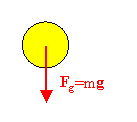 Example:
Example:Newton's second law: Fnet = ma
To find the net force on an object, all the vector forces that act on the object have to be added. We use free-body diagrams to help us with this task. Free-body diagrams are diagrams used to show the relative magnitude and direction of all forces acting on an object in a given situation. The object is represented by a box or some other simple shape. The forces are represented by arrows. The length of the arrow in a free-body diagram is proportional the magnitude of the force. The direction of the arrow gives the direction of the force. Each force arrow in the diagram is labeled. All forces which act on the object must be represented in the free-body diagram. A free body diagram only includes the forces that act on the object, not the forces the object itself exerts on other objects.
 Example:
Example:A free-body diagram for a freely falling ball:
Neglecting air friction, the only force acting on the ball is gravity.
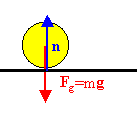 Example:
Example:A free-body diagram for a ball resting on the ground:
Gravity is acting downward. The ball is at rest. The ground must exert
a force equal in magnitude and opposite in direction on the ball. This
force is called the normal force, n, since it is normal to the surface.
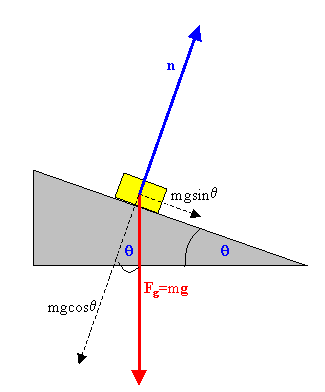 Example:
Example:A free-body diagram for a mass on an inclined plane:
Gravity acts downward. The component of
Fg
perpendicular to the surface is cancelled out by the normal force the
surface exerts on the mass. The mass does not accelerate in the
direction perpendicular to the surface. The component of Fg
parallel to the surface causes the mass to accelerate in that direction.

Suppose that you want to move a heavy file cabinet,
which is standing in the middle of your office, into a corner. You push
on it, but nothing happens. What is going on?
You exert a force, but there is no acceleration. The net force
must be zero.
Which force of equal magnitude points in a direction opposite to the
direction of the force you are applying?
The force of static friction
(fs) cancels the applied force when the cabinet is
at rest while you are pushing on it.
You push harder. Eventually the cabinet breaks away and starts
accelerating. But you have to keep on pushing just to keep it moving
with a constant velocity. When you stop pushing, it quickly slows down
and comes to rest. Why?
While the cabinet is moving the force of
kinetic friction (fk) opposes the
applied force. When it is moving with constant velocity, the two
forces exactly cancel.
Where do these frictional forces come from? Frictional forces are intermolecular forces. These forces act between the molecules of two different surfaces that are in close contact with each other. On a microscopic scale, most surfaces are rough. Even surfaces that look perfectly smooth to the naked eye show many projections and dents under a microscope. The intermolecular forces are strongest where these projections and dents interlock resulting in close contact. The component of the intermolecular force normal to the surfaces provides the normal force which prevents objects from passing through each other and the component parallel to the surface is responsible for the frictional force.
 Assume a cabinet is resting on the floor. Nobody
is pushing on it. The net intermolecular force between the
molecules of two different surfaces is normal to the surface.
The force of gravity acting on the cabinet (red arrow)
is balanced by the normal force from the floor acting on it (black arrow).
Assume a cabinet is resting on the floor. Nobody
is pushing on it. The net intermolecular force between the
molecules of two different surfaces is normal to the surface.
The force of gravity acting on the cabinet (red arrow)
is balanced by the normal force from the floor acting on it (black arrow).
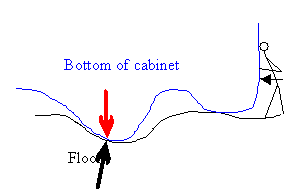 Now assume that you are pushing against the cabinet.
The cabinet is not moving, but the surface molecules are displaced by
microscopic amounts. This results in a net intermolecular force, which has a
component tangential to the surface (the force of static friction).
This tangential component opposes the applied force. The net force on
the cabinet is zero. The harder you push the greater is the microscopic
displacement of the surface molecules and the greater is the tangential
component of the net intermolecular force.
Now assume that you are pushing against the cabinet.
The cabinet is not moving, but the surface molecules are displaced by
microscopic amounts. This results in a net intermolecular force, which has a
component tangential to the surface (the force of static friction).
This tangential component opposes the applied force. The net force on
the cabinet is zero. The harder you push the greater is the microscopic
displacement of the surface molecules and the greater is the tangential
component of the net intermolecular force.
When you push hard enough, some of the projections on the surfaces will break off, i.e. some of the surface molecules will be completely displaced. The horizontal component of the net intermolecular force diminishes and no longer completely opposes the applied force. The cabinet accelerates. But while the horizontal component has diminished, it has not vanished. It is now called the force of kinetic friction. For the cabinet to keep accelerating, you have to push with a force greater in magnitude than the force of kinetic friction. To keep it going with constant velocity you have to push with a force equal in magnitude to the force of kinetic friction. If you stop pushing, the force of kinetic friction will produce an acceleration in the opposite direction of the velocity, and the cabinet will slow down and stop.
The frictional force always acts between two surfaces, and opposes the relative motion of the two surfaces.
The maximum force of static friction between two surfaces is roughly proportional to the magnitude of the force pressing the two surfaces together. The proportional constant is called the coefficient of static friction μs. The magnitude of the force of static friction is always smaller than or equal to μsN, We write fs ≤ μsN, where fs is the magnitude of the frictional force and N is the magnitude of the force pressing the surfaces together. For the cabinet and the floor, N is the weight of the cabinet. The coefficient of static friction is a number (no units). The rougher the surface, the greater is the coefficient of static friction.
As long as the applied force has a magnitude smaller than μsN, the force of static friction fs has the same magnitude as the applied force, but points in the opposite direction.
The magnitude of the force of kinetic friction acting on an object is fk = μkN, where μk is the coefficient of kinetic friction. For most surfaces, μk is less than μs.
This short video clip illustrates the difference between static and kinetic friction.
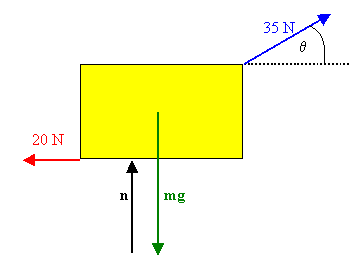 A woman at an airport is towing her 20 kg suitcase
at constant speed by pulling on a strap at an angle of θ above the horizontal.
She pulls on the strap with a 35 N force, and the
frictional force on the suitcase is 20 N.
A woman at an airport is towing her 20 kg suitcase
at constant speed by pulling on a strap at an angle of θ above the horizontal.
She pulls on the strap with a 35 N force, and the
frictional force on the suitcase is 20 N.
(a) Draw a free body diagram of the suitcase.
(b) What angle does the strap make with the horizontal?
(c) What normal force does the ground exert on the suitcase?
Solution:
 Problem:
Problem: Determine the stopping distance for a skier with a speed of 20 m/s on a slope that makes an angle θ with the horizontal. Assume μk = 0.18 and θ = 5o.
Solution:
Suppose you are driving a car along a highway at a high speed. Why should you avoid slamming on your brakes if you want to stop in the shortest distance? That is, why should you keep the wheels turning as you brake?
Solution:
 A heavy box sits in the back of a pickup truck. The truck and the box
are accelerating towards the left. What is the direction of the
frictional force on the box?
A heavy box sits in the back of a pickup truck. The truck and the box
are accelerating towards the left. What is the direction of the
frictional force on the box?
Solution: